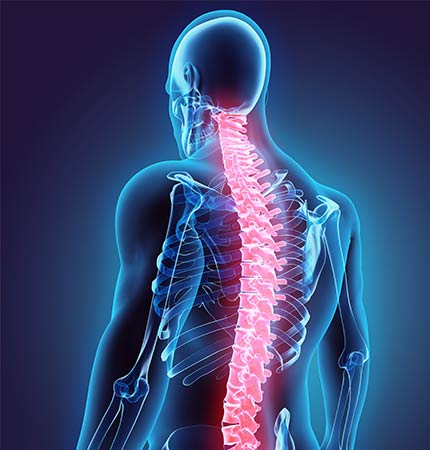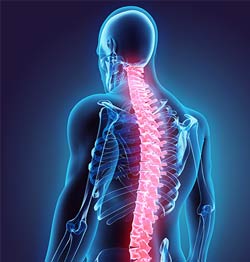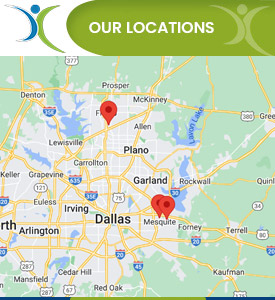Spinal Cord Stimulation Therapist Serving DFW, Frisco, Sunnyvale and Mesquite TX
OmniSpine pain management provides spinal cord stimulation therapy, a non-surgical treatment for back pain relief. The stimulation interferes with the message of pain to the Brain which results in the patient not experiencing their usual pain symptoms. Our clinics are located in Frisco, TX, Sunnyvale, TX, and Mesquite, TX. For more information, contact us today or book an appointment online.




Table of Contents:
Who are good candidates for spinal cord stimulation?
Spinal cord stimulation is a therapy that interrupts pain signals before they reach the brain. It involves a minimally invasive procedure to implant a small device, similar to a pacemaker, that delivers electrical pulses to the spinal cord. It is a useful tool in the treatment of chronic pain symptoms, especially those that do not improve with first-line therapies. Spinal Cord Stimulation is especially effective in patients who have undergone low back or neck surgery and continue to experience pain after these surgeries.
The spinal cord stimulator (SCS) works by stimulating the nerves in the area where the pain is located. Through electrodes placed over the spinal cord, these electrical pulses modify and disrupt the communication of pain from the nerves to the brain. Tingling can sometimes accompany the stimulation. Dr. Morchower utilizes spinal cord stimulation in many of his patients who have undergone spine surgery without improvement or patients who would prefer not to proceed with any spine surgery. Patients enjoy the opportunity to try the stimulation BEFORE committing to proceeding with having a spinal cord stimulator. Dr. Morchower always has the patient trial the spinal cord stimulator device for 3-5 days before proceeding with the actual procedure. If patients find that spinal cord stimulator therapy is not effective for them, then the leads are taken out and the patient is only left with a needle stick that heals within a day or two.
Candidates for Spinal Cord Stimulation (SCS) typically have had chronic debilitating pain for at least three months in the lower back, legs (especially sciatica), or arms. Other qualifications include:
• Failed conservative therapies, such as oral and topical medications, or physical therapy
• Further surgery is unlikely to provide additional benefit or poses too much risk of complications
• Chronic Sciatica
• Spinal Stenosis
• Peripheral Neuropathies
• Failed Back Surgery Syndrome which occurs when there is a failure of one or more surgeries to relieve pain.
• Complex Regional Pain Syndrome (CRPS, RSD)
• Arachnoiditis, a painful inflammation from damage or scarring of the protective lining of the spinal nerves
• Phantom limb pain
• Peripheral Nerve Damage
The Procedure
Before permanent placement of the spinal cord stimulator is made, a trial is performed first to see if the stimulator is successful in reducing symptoms. In an outpatient setting, the area of the back that will be treated is cleaned and draped in a sterile fashion. A numbing medicine is injected superficially to numb the skin. Under the guidance of fluoroscopy x-ray, a needle is inserted through the skin into the epidural space of the spine. The lead of the trial stimulator is inserted and positioned over specific nerves. The wires from the lead are attached to an external generator that is then worn on a belt or other outer garment. Instructions on how to use the trial stimulator will be given and you will have a representative assigned to you during the duration of your trial. After 3 to 5 days, a follow-up visit will be scheduled to discuss the results and whether or not permanently implanting the stimulator would be beneficial for you.
If permanent spinal cord stimulation is determined to be beneficial, the minimally invasive implantation procedure will be scheduled.
The Results
Once the spinal cord stimulator has been programmed, instructions for regulating the stimulation by controlling the strength and the duration of each stimulation period will be given. The pulse width, amplitude, and frequencies may be adjusted at follow-up visits with Dr. Morchower if necessary.
The goal for spinal cord stimulation is pain reduction, significant enough to allow the individual to perform daily activities with less pain and a reduction in the amount of pain medication needed. Our clinics are located in Frisco, TX, Sunnyvale, TX, and Mesquite, TX. For more information, contact us today or book an appointment online. We serve patients from Dallas TX, Frisco TX, Mesquite TX, Sunnyvale TX, Plano TX, Garland TX, Forney TX, Cedar Hill TX, Denton TX, Balch Springs TX, and surrounding areas.
*Individual Result May Vary*





